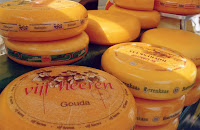Giverny, the Village
At the gateway to Normandy, 75 km from Paris and 60 km from Rouen, the village of Giverny (pronounced Jee-va-nyee) is located on the right bank of the River Seine, at its confluence with one of the two branches of the River Epte lined with willows and poplars.
The origin of the village is very ancient as Gallo-Roman graves are said to have been discovered there in 1838. In 1860 coffins made out of plaster and dating from the first centuries of our era were found while restoring the churchyard. A ruined megalithic monument close to the church and called "Saint Radegonde's grave" also testifies that neolithic people used to live there.
But Giverny rises to fame in 1883 when the painter Claude Monet discovered the village whilst looking out of the train window (the line has since closed down). Monet was enthusiastic about the spot. He found a large house to rent, "the Press House". By the end of April he had moved in with Alice Hoschedé, his lady-friend, his two sons and her six children. The house was a farmhouse with a vegetable garden and an orchard of over one hectare.
At the time there were about 300 inhabitants in Giverny, most of them farmers, and a few middle-class families.
The village consists of two streets on the hillside lined with low houses in a pink or green roughcast with slate roofs, their walls covered with wisteria and Virginia creeper. These streets are crossed by narrow lanes running down the hill. The Claude Monet Road runs straight to the village. The "Chemin du Roy" (Secondary Road 5) follows the banks of the River Epte. Claude Monet's house lies between the two roads.
From 1887 onwards a colony of foreign painters, mainly Americans settled in Giverny. But this seems to have been by chance and the charm of the place rather than the presence of Monet (which they did not know of). The painters Sargent, Metcalf, Ritter, Taylor, Wendel, Robinson, Bruce and Breck came first.
For thirty years about a hundred artists stayed one after the other in Giverny, although they did not have much contact with Monet who considered their presence a nuisance. However their art would be deeply influenced by impressionist techniques.
Much more here
About Claude Monet
Claude Monet was born on November 14, 1840 on the fifth floor of 45 rue Laffitte,in the ninth arrondissement of Paris. He was the second son Claude Adolphe Monet and Louise-Justine Aubree. On the first of April 1851, Monet entered the Le Havre secondary school of the arts. He became known locally for this charcoal caricatures, which he would sell for ten to twenty francs. Monet also undertook his first drawing lessons from Jacques-Francois Ochard, a former student of Jacques-Louis David. On the beaches of Normandy in about 1856/1857 he meet fellow artist Eugéne Boudin who became his mentor and taught him to use oil paints. Boudin taught Monet "en plein air" (outdoor) techniques for painting.
View his complete works here
Further Reading about Claude Monet and the Gardens
"In 1900, Monet has become famous. On the occasion of an exhibition in Paris a journalist, Thiébault-Sisson, made him tell his life. On November 26, 1900 the newspaper "Le Temps" published this autobiography in which Monet builds himself his legend. The text is spicy but doesn't always reflect reality faithfully ..."
Monet's Impressions
Throughout his life, Claude Monet wrote and spoke about his art. This elegant book pairs spectacular reproductions of some of his most important paintings with his own words to create a uniquely personal look at the work of one of the worlds most renowned artists. The poetic text introduces readers to the Impressionists' goal of capturing a fleeting moment and makes this an art book perfect for the young and the young at heart.
Secrets of Monet's Garden: Bringing the Beauty of Monet's Style to Your Own Garden by Derek Fell
Monet designed his garden as a painter’s subject, using plants like brushstrokes. Premier garden writer and photographer Derek Fell helps the home gardener recreate some of Giverny’s beauty through an illuminating examination of the painter’s planting philosophies. With hundreds of full-color photographs, and reproductions, Fell sheds light on Monet’s use of color, structure, favorite flowers; and more.




















